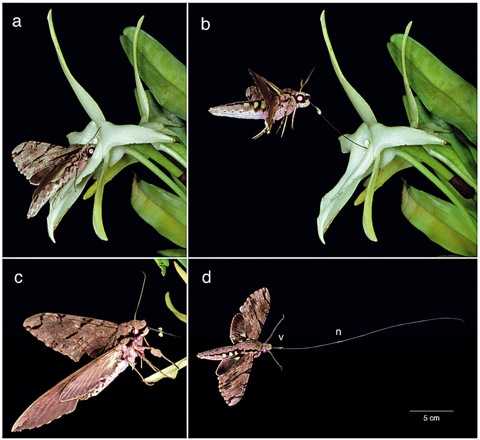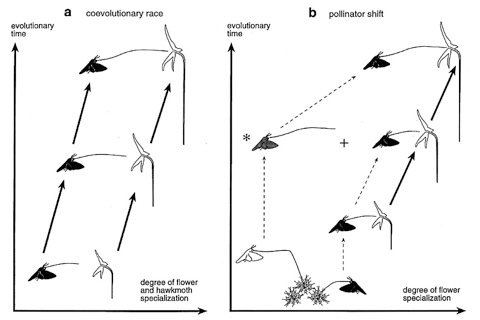Wasserthal, L.T. (1997): The pollinators of Malagasy star orchids Angraecum sesquipedale, A. sororium and A. compactum and the evolution of extremely long spurs by pollinator shift. Botanica Acta 110, 343-359.
The pollination process of the extremely long-spurred orchids Angraecum sesquipedale and A. sororium is described and documented here for the first time. The pollinaria and viscid load was examined in moths captured in central and south Madagascar. Visits to orchids by hawkmoths were rarely observed in the field and were therefore systematically recorded in large flight tents using night-vision video technique and flashlight photography. Angraecum sesquipedale in Fort Dauphin is pollinated by Xanthopan morgani praedicta and A. sororium on Mount Angavokely by Coelonia solani. By combining a deep nectar spur of extraordinary length with a protruding labellum functioning as a landing platform, these orchids overcome the moth's stereotypic swing-hovering flight thus enabling full insertion of the long tongue. Angraecum compactum in Forêt d'Ambohitantely is pollinated by both the shorter and longer-tongued forms of Panogena lingens which never swing-hover but is also exploited by X. morgani and C. solani under wastage of pollinaria. The duration of tongue insertion, nectar exploitation and tongue withdrawal were analyzed: legitimate and illegitimate visitors differ in their time budget and approach to the flower. Nectar volume, nectar level and sugar concentration of A. sesquipedale and A. sororium were compared with the nectar requirements of the pollinating hawkmoths. The evolution of very long spurs in these orchids is likely to have involved a series of pollinator shifts. The orchids adapted to different hawkmoth species with increasingly long tongues which primarily evolved to avoid predator attacks during visits to less specialized flowers. This "pollinator shift" model modifies the classical "coevolutionary race" model. The relevance of the taxon Angraecum bosseri Senghas is questioned.

First documentation of Xanthopan visiting Angraecum sesquipedale in 1992. a) The moth is forced to take seat on the protruding labellum of the orchid thus avoiding swing-hovering. b) The moth retracts the polliaria when leaving the flower. c) female moth seizing the labellum prior to depositing the pollinaria on the stigma. d) Male moth captured in the wild with adhering viscidium (v) and remnant nectar (n) from a former pollinaria transfer.
Comparison of Darwins coevolution model (a) versus pollinator shift model (b).

